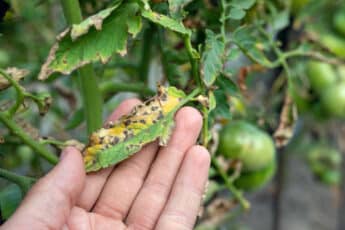Vital and healthy soil is the basis for good harvests and a sustainable agricultural future. Every bite of delicious, sweet summer fruit or crunch of healthy nut seeds nourishes the soil, motivating plants to develop strong roots and survive the winter.
What supports life on Earth is soil. To develop and thrive, plants require a variety of creatures, fluids, and mineral particles found in the Earth’s upper crust. From disease resistance to winter hardiness to fruit quality and flavor, plants depend on soil for various reasons. Soil is home to more than 25% of Earth’s biodiversity. Healthy soil is good for everyone who eats it. Soil accounts for 95% of food production! Understanding the role of soil health in plant disease prevention is essential for sustainable farming practices.
Let’s explore the role of soil health in plant disease prevention.
What is Soil Health?
The ability of soil to sustainably support plant growth, maintain or improve water and air quality, and promote biodiversity is known as soil health. In addition, healthy soil is a stable habitat that supports all necessary biological processes, supports a diverse community of soil organisms that help control plant diseases, insects, and weeds that form beneficial symbiotic associations with plant roots, and supports a variety of living organisms in a manner that they could coexist in a balanced ratio and help break down organic matter, recycle vital nutrients and improve soil structure, positively impacting the soil’s ability to retain water and nutrients. The key components of soil health include:
- Soil Structure: Well-aggregated soil improves root penetration and water infiltration, reducing erosion and runoff.
- Nutrient Availability: Balanced levels of essential nutrients like nitrogen, phosphorus, and potassium support plant growth and development.
- Organic Matter: High organic matter levels improve soil structure, water-holding capacity, and nutrient availability.
- Microbial Activity: A diverse and active microbial community enhances nutrient cycling and suppresses soil-borne pathogens.
- pH Balance: Optimal pH levels ensure nutrient availability and microbial activity.
Soil Health and Disease Suppression
Healthy soil creates an environment where plants can thrive and pathogens struggle to take hold. Here are several ways in which soil health contributes to plant disease prevention:
Enhanced Microbial Competition
A rich and diverse microbial community in the soil competes with pathogenic organisms for resources and space. Beneficial microbes, such as mycorrhizal fungi and rhizobacteria, form symbiotic relationships with plants, enhancing their nutrient uptake and overall health. These beneficial organisms can outcompete and inhibit the growth of harmful pathogens, reducing the incidence of diseases.
Induced Systemic Resistance
Certain soil microbes can trigger plants’ natural defense mechanisms through a process known as induced systemic resistance (ISR). When beneficial microbes colonize plant roots, they can stimulate the plant’s immune system, making it more resistant to many pathogens. This heightened state of alert helps plants fend off diseases more effectively.
Improved Soil Structure and Drainage
Healthy soil with good structure allows for proper water infiltration and drainage, preventing waterlogging and anaerobic conditions that favor the growth of root-rotting pathogens. Well-drained soils also reduce the likelihood of diseases caused by waterborne pathogens.
Soil pH and Disease Suppression
Soil pH can influence the availability of nutrients and the activity of soil microorganisms. Most plants prefer a slightly acidic to neutral pH. Extremes in pH can stress plants and disrupt the balance of the soil microbiome, making it easier for pathogens to invade. Managing soil pH through lime or sulfur applications can help maintain a conducive environment for plant health and disease resistance.
Optimal Nutrient Balance
Balanced nutrient levels in the soil support strong and healthy plant growth, making plants less susceptible to diseases. Over-fertilization or nutrient imbalances can weaken plants, making them more prone to infections. Maintaining soil health ensures that plants receive the right amount of nutrients they need to thrive.
The Soil Microbiome: Nature’s Defense System
Microbes are crucial to soil health by contributing to nutrient cycling, disease suppression, and plant growth promotion. The soil teems with microorganisms, including bacteria, fungi, protozoa, and nematodes. These organisms form a complex web of interactions that benefit plant health. A diverse and balanced soil microbiome can outcompete pathogenic organisms, preventing them from establishing and causing disease. Beneficial microbes can also produce antibiotics and other substances that inhibit the growth of harmful pathogens.
Organic Matter and Soil Amendments
Incorporating organic matter, such as compost or cover crops, into the soil enhances its structure, water-holding capacity, and nutrient availability. Organic matter also supports the growth of beneficial microbes that suppress soil-borne pathogens. Additionally, certain organic amendments, such as neem cake or biochar, have natural pesticidal properties that help reduce disease pressure.
What management practices can decrease disease outbreaks?
Disease outbreaks are less likely if management practices limit the spread of pathogens by creating unfavorable soil conditions for their growth. Follow these simple steps for healthy soil in your garden.
- Regular Soil Testing: Conduct soil tests to monitor nutrient levels, pH, and organic matter content. Adjust fertilization practices based on test results to maintain optimal soil health.
- Crop Rotation and Diversity: Rotate crops to prevent the buildup of specific pathogens and diversify plantings to support a variety of beneficial soil organisms.
- Use of Cover Crops: Plant cover crops during off-seasons to add organic matter, improve soil structure, and support microbial diversity.
- Composting: Apply compost to enrich the soil with organic matter and beneficial microbes.
- Reduced Tillage: Minimize soil disturbance to preserve soil structure and protect microbial habitats.
- Integrated Pest Management (IPM): Employ IPM practices to manage pests and diseases in a sustainable and eco-friendly manner.
Conclusion
Good soil health benefits productivity, sustainability, and profitability. By fostering a vibrant and balanced soil ecosystem, gardeners and farmers can enhance plant resilience, reduce the need for chemical interventions, and promote sustainable agricultural practices. Healthy soil not only supports robust plant growth but also plays a crucial role in creating a more sustainable and disease-resistant growing environment.
Contact Greenwood Tree Company to discuss different practices to protect soil and learn more.







